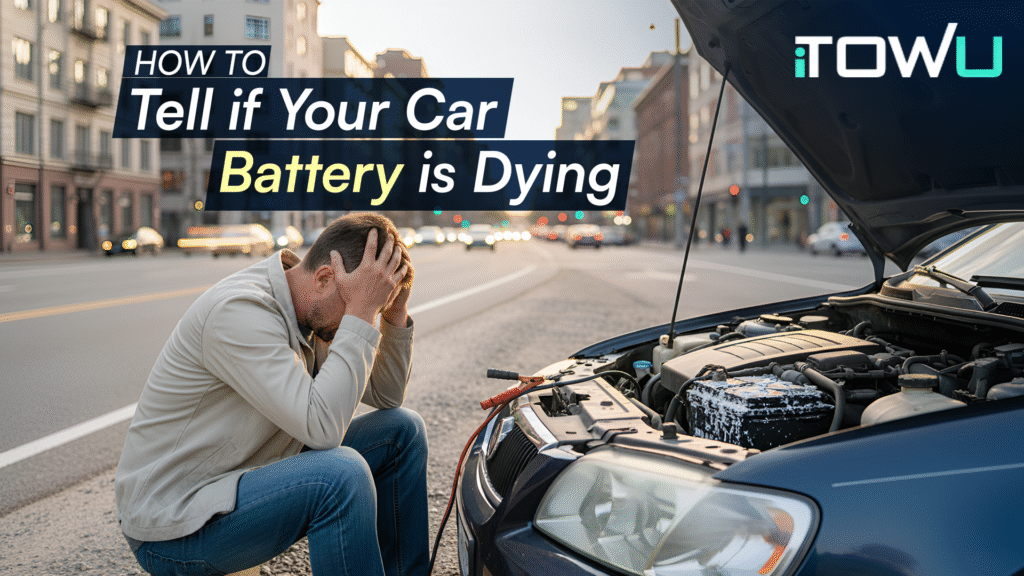Let’s say you’re late, and you put the key in and start your car. But nothing happens—just a weak click or silence. Well, I’m sure we’ve all been in that situation before or know someone who has.
The reality is, car batteries typically don’t fail overnight. They signal it through little symptoms that may go ignored at first. So, recognizing these red flags early can help you avoid stress, setbacks, and surprise costs.
Below, I’m going to cover all seven signs your car battery is dying (and how to detect them before they drain all the juice) in this guide.
7 Signs your car battery is dying (And what to do next)
Your car battery rarely dies without warning. Slow starts, dim lights, or odd clicks are early clues.
Here are seven signs your battery is failing and what to do next.
1) Slow engine crank that gets worse over time
When the engine cranks slowly—that long, labored rrr-rrr sound—it’s a classic sign of a weak battery. You’ll notice it especially after the car has sat overnight or in cold weather. A healthy battery supplies enough cranking amps for the starter to spin the engine briskly. A weak one struggles. The slow crank often worsens over time. So, pay attention to changes. Before you end up with a dead car battery in your driveway, schedule a battery check at a local shop or be ready to call for a battery jump start.
2) Random electrical glitches
Modern vehicles are loaded with electronics, touchscreens, Bluetooth, heated seats, sensors, etc. A weak battery can’t keep voltage steady, which makes these systems act up. These quirks are often blamed on the car’s electronics, but they’re actually common symptoms of bad car battery performance. A quick way to confirm is to test the car battery with a multimeter. Typically, the battery voltage should be around ~12.6 V at rest, and ~13.8–14.6 V when running.
3) Clicking sound instead of starting
You turn the key on your car and hear a rapid clicking from the engine bay. That’s the starter solenoid chattering due to low battery voltage. It also means the battery isn’t supplying enough power to the starter motor. This is a classic sign of a weak or failing battery. It may still power the radio or the lights, but not crank the engine. Often, the battery is near the end of its life, but confirm with a quick inspection before replacing. Do this before you get stranded or worse, needing to tow your car when it won’t start at all.
4) Corrosion around the battery terminals
Lift the hood and inspect the battery. If there is white, blue, or green buildup around the battery terminals, then it is corrosion. It blocks the flow of electricity, forcing your battery to work harder than it should. Cleaning the corrosion with a brush can help in the short term, but if it keeps returning, it often means the battery is leaking or nearing the end of its life. At that point, replacing the car battery is a must rather than fighting a losing battle.
5) Swollen or misshapen battery case
Your battery’s outer case should have a flat and smooth surface. If it’s swollen, bulging, oddly shaped, or leaking, that’s not normal. Heat, freezing when discharged, overcharging, or internal damage can cause the case to expand. A swollen battery is very unsafe and unreliable. Even if your car still starts, you should plan a new car battery installation immediately.
6) The battery is over three years old
Most car batteries last 3–5 years, but heat, winter cold, frequent short trips, and long sits can shorten that. Don’t wait for a failure to happen. Starting in year two, get an annual battery test and charging-system check. Proactive replacement around year four (earlier in very hot climates or with severe use) can prevent surprise no-starts.
7) Inconsistent performance after a jump
Sometimes a jump-start seems to fix things, but the battery feels weak again days later. If the problem returns, it’s likely more than a one-time drain. The battery may not be holding a charge. You can confirm it with a resting and load test. If it fails, replace it. Also, verify the charging system (~13.8–14.6 V running) and check for parasitic draw, so you don’t end up stranded or needing a tow.
Last Note
A dying car battery is one of those problems that sneaks up when you least expect it. One day it’s just a slow crank, the next day it’s a silent key turn. But as you’ve seen, the seven signs your car battery is dying are there; you just need to pay attention.
And if you do get stuck, the iTOWu app makes it easy to request quick help for vehicle towing or roadside assistance. Stay alert, replace your battery on time, and you’ll avoid being stranded when you need your car most.
